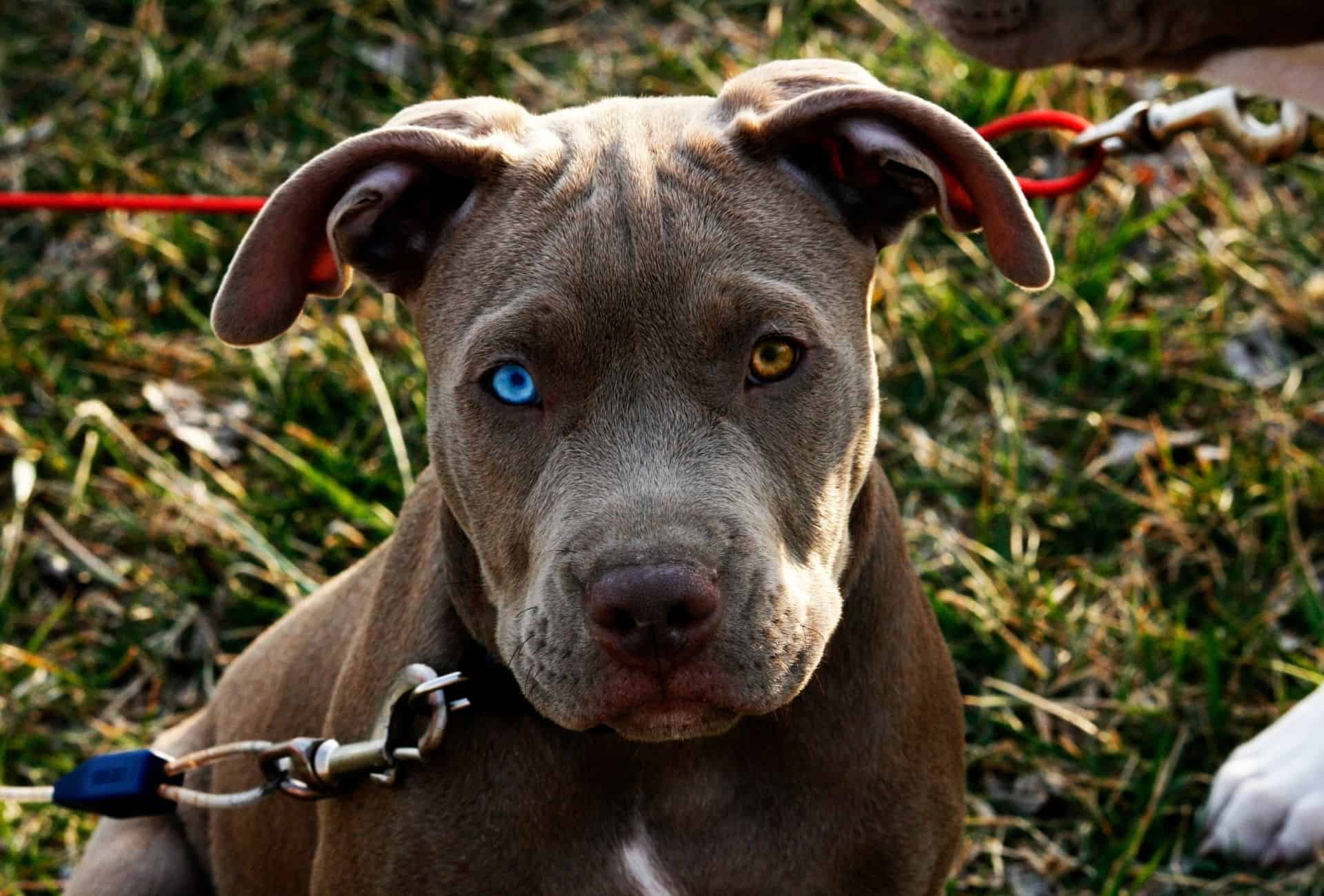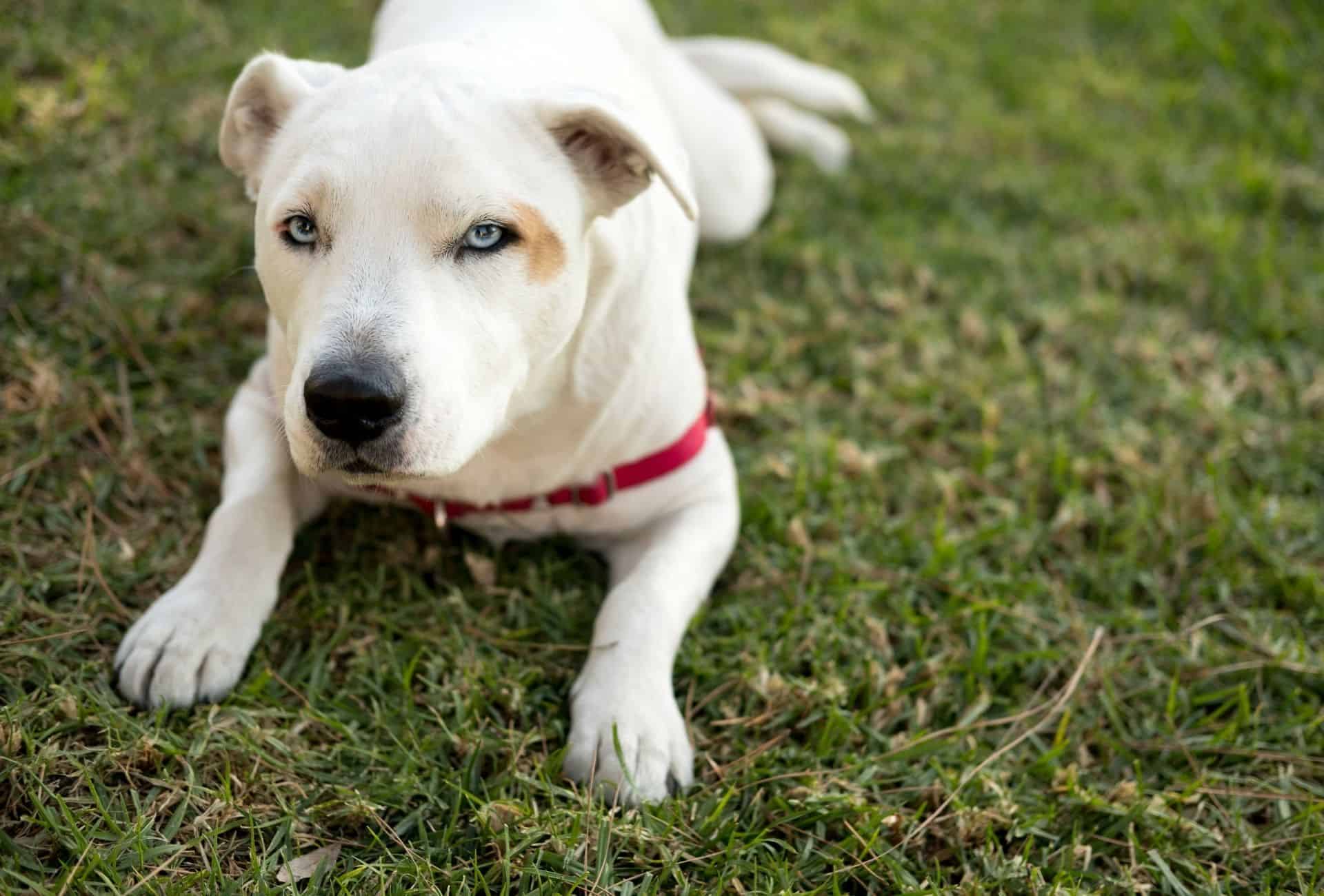The United Kennel Club (UKC) says that the American Pit Bull Terrier (APBT) is a result of breeding an Old English Bulldog and a Terrier to get a dog that has the strength of the bulldog and the agility of the terrier breed.
The Pitbull Terrier gained popularity in Britain for the bloody sport of bull baiting where one to two APBT dogs were set to harass a bull for hours until the animal collapsed from fatigue or injuries.
When bull baiting was outlawed, the APBT was used for dogfighting and ratting. Still, bloody sports.
Immigrants to America brought this bull and terrier mix. As the bloody sports became unpopular and outlawed, Pitbulls became farm dogs and companions.
Today, Pitbulls battle bad publicity, but they’re genuinely kind dogs with big hearts full of love.
How Long Do Pitbull Puppy Eyes Stay Blue?
You may get a first glimpse at your Pitbull’s adult eye color around the age of 4 months.
Their puppy coat will be replaced by a much thicker and darker adult coat when they are 6 months old.
Blue-eyed Pitbull puppies are not rare and their eye color will most likely change over time.
So don’t choose the one bright-eyed Pitbull in the litter just because of his appearance.
Even if a breeder sells them as “rarity” for a premium, the color will almost certainly vanish (if it’s a purebred, more on that below).
That being said, while blue eyes are not particularly rare for Pitbull puppies, not every pup has blue eyes.
Check out my Cane Corso colors article for more information on how breeders try to falsely label colors.
Breeding for a specific color or coat type should always be a red flag when choosing a responsible breeder.
When specific looks are the primary breeding factor, other traits like temperament or health are disregarded.
You might find that the prettiest dog in a litter will have lots of health issues behind the facade.
Always make sure that the parents have health certificates and the right behavioral traits you are looking for.
Check out my article on questions to ask your breeder to avoid falling prey to these “breeders”.

Inbreeding in dogs is another huge issue and will be used to pass a certain appearance on to future generations.
As you might imagine, inbreeding comes with the worst health concerns and should never be encouraged.
Merle describes a beautiful coat color pattern that can create odd-colored eyes. It’s commonly seen in these breeds:
The merle gene sadly comes with many health issues like deafness and blindness.
Double merles (MM) are extremely prone to these genetic diseases and therefore merles should never be bred together.
Heterozygous merles (Mm) are way healthier and resemble the merle pattern best.
A Pit Bull with a merle coat pattern is excluded from the APBT breed standard and might not be purebred because the gene must have somehow found its way into the bloodline.
Tyrosinase is an enzyme that controls the production of melanin.
Albino dogs are “tyrosinase-negative” meaning that their body is incapable of producing melanin.
Therefore, these dogs will be born with a unique white coat, blue eyes and a pink nose.
Albinism in dogs is an extremely rare mutation and both parents need to carry the recessive gene.
Be very cautious when a breeder is trying to sell you a rare white pitbull.
Albinism comes with many health issues, including deafness or skin cancer.
Due to their pale coat, they must be protected from direct sunlight at all times using either bodysuits or sunscreen.

White patches around the eyes or nose can occur due to a lack of pigmentation.
Pit Bulls or any other breed with dominant white coats can develop light eyes or a pinkish nose.
Do Blue Eyed Dogs Go Blind?
Dogs with blue eyes are not necessarily doomed to develop any vision-related issues.
It largely depends on the specific reason your dog might have this eye color.
Pit Bulls are not among the breeds that carry this breed-specific gene, meaning that they probably will develop health problems later on.
You should stay away from the merle gene and albinism.
If you find a responsible breeder that has legitimate puppies with blue eyes, there is probably nothing you need to worry about as the color will start transforming at the age of 4 months.
Pitbull With Blue Eyes Coat Color Examples (With Pictures)
In this section, I will be presenting some pictures of Pitbulls, who have rare blue eye coloring. These dogs may have acquired the M locus or have low melanin levels inherited from their parents.

Grey Pitbull with blue eyes is one of the most common. Look at this pup, who isn’t shy to stare at a camera.

White blue-eyed Pitbulls are often affected by albinism. The absence of any pigment on this dog’s coat tells us exactly of its condition.

The black Pitbull with blue eyes is a sight to behold because it is a mystery how they are produced. They are very rare since Pitbulls only acquire a black coat color if they have high melanin levels, and they possess blue eyes because of the low levels of melanin.
FAQ
How much is a GREY pitbull with blue eyes?
Do GREY pitbulls have blue eyes?
What breed is a pitbull with blue eyes?
The Grey APBT, also known as the American Grey Pitbull and American Pitbull Terrier Grey, is the most notorious Pitbull breed.